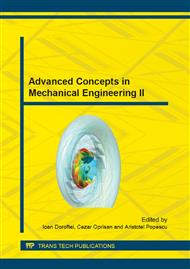p.3
p.10
p.16
p.22
p.28
p.34
p.40
p.46
p.51
Corrosion Behaviour of a Cermet Deposited Coating in Sulfuric Acid Solution
Abstract:
Gas oil is the fuel used in internal combustion engines with ignition through compression. This fuel contains various amounts of sulfur, an element that can contribute in the process of combustion to the forming of sulfuric acid on the internal walls of the cylinder. Sulfuric acid is a highly corrosive substance which can lead in time to the deterioration of the functional surface of the motor cylinder. For an accurate evaluation of the analyzed coatings a study was carried out on the resistance to sulfuric acid corrosion of the two coatings of Al2O3 30(Ni20Al) and NiAlSi. To this purpose a solution of sulfuric acid with a 30% concentration was used. The samples were immersed in sulfuric acid for 70 hours.
Info:
Periodical:
Pages:
28-33
Citation:
Online since:
October 2014
Keywords:
Price:
Сopyright:
© 2014 Trans Tech Publications Ltd. All Rights Reserved
Share:
Citation:


